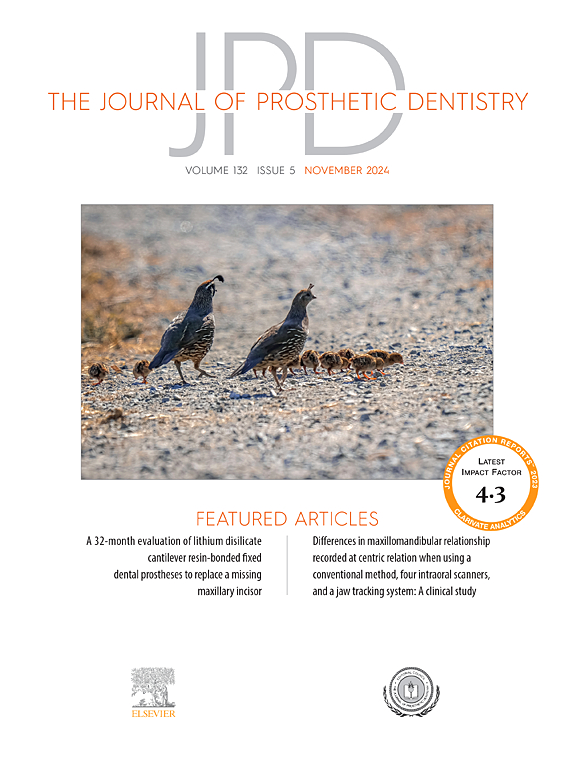Proposal regarding horizontal and vertical positioning of single implants placed in healed sites: Effect on cervical crown form and the need for bone grafting
IF 4.3
2区 医学
Q1 DENTISTRY, ORAL SURGERY & MEDICINE
引用次数: 0
Abstract
Statement of problem
When single implants are placed in healed sites, guidelines are lacking on the horizontal and vertical implant positions that optimize cervical crown form and the implant locations that would require bone grafting to develop the optimal crown form.
Purpose
The purpose of this clinical study was to evaluate the cervical contour of wax patterns formed on casts of single implants placed in healed sites and to determine which horizontal and vertical implant positions produced the best cervical crown form and which indicated the need for bone grafting.
Material and methods
Fifty-eight wax patterns were fabricated on casts where implants had been placed in healed sites without bone grafting. The wax patterns were subjectively assessed by 5 dental faculty members and 5 graduate students as having good, fair, or poor cervical crown form. Horizontal measurements were made between the facial surface of the implant and a round metal wire connecting the gingival zeniths of the adjacent teeth. Vertical measurements were also made between the wire and implant platform. The subjective assessments along with the horizontal and vertical implant position measurements were used to propose guidelines for optimal implant placement in healed sites.
Results
Horizontal distances of 2.0 to 3.0 mm produced good cervical crown contours, with distances >3.0 mm and <2.0 mm resulting in fair or poor assessments. Vertical distances of 3.0 to 4.0 mm were judged to have good cervical crown contour, whereas depths of 1.0 mm or less were assessed as poor.
Conclusions
Based on the subjective assessment of wax patterns formed on casts of single implants placed in healed sites, a guideline of 2.0 to 3.0 mm is proposed for the horizontal distance between a line connecting the adjacent gingival zeniths and the facial surface of the implant. A vertical distance guideline of 3.0 to 4.0 mm is proposed between the adjacent gingival zeniths and the implant platform.
关于在愈合部位植入单个种植体的水平和垂直定位的建议:对颈椎冠形态和植骨需求的影响。
问题陈述:在愈合部位植入单颗种植体时,缺乏有关水平和垂直种植体位置的指导,而这些位置可以优化颈冠形态,同时也缺乏需要植骨才能形成最佳颈冠形态的种植体位置的指导。目的:本临床研究的目的是评估在愈合部位植入单颗种植体的铸模上形成的蜡型的颈部轮廓,并确定哪些水平和垂直种植体位置可以产生最佳颈冠形态,哪些位置需要植骨:在未植骨的愈合部位植入种植体的模型上制作了 58 个蜡型。蜡型由 5 名牙科教师和 5 名研究生主观评定,分为颈冠形态良好、一般或较差。水平测量是在种植体表面和连接邻牙龈嵴的圆形金属丝之间进行的。此外,还在金属丝和种植体平台之间进行了垂直测量。主观评估结果与水平和垂直方向的种植体位置测量结果一起,用于提出在愈合部位进行最佳种植体植入的指导原则:结果:水平距离为 2.0 至 3.0 毫米时,牙颈部的牙冠轮廓良好,距离大于 3.0 毫米时,牙颈部的牙冠轮廓较差:根据对在愈合部位植入的单颗种植体铸模上形成的蜡型的主观评估,提出了相邻牙龈天顶连接线与种植体面部之间的水平距离准则为 2.0 至 3.0 毫米。相邻龈嵴与种植体平台之间的垂直距离准则为 3.0 至 4.0 毫米。
本文章由计算机程序翻译,如有差异,请以英文原文为准。
求助全文
约1分钟内获得全文
求助全文
来源期刊

Journal of Prosthetic Dentistry
医学-牙科与口腔外科
CiteScore
7.00
自引率
13.00%
发文量
599
审稿时长
69 days
期刊介绍:
The Journal of Prosthetic Dentistry is the leading professional journal devoted exclusively to prosthetic and restorative dentistry. The Journal is the official publication for 24 leading U.S. international prosthodontic organizations. The monthly publication features timely, original peer-reviewed articles on the newest techniques, dental materials, and research findings. The Journal serves prosthodontists and dentists in advanced practice, and features color photos that illustrate many step-by-step procedures. The Journal of Prosthetic Dentistry is included in Index Medicus and CINAHL.
 求助内容:
求助内容: 应助结果提醒方式:
应助结果提醒方式:


